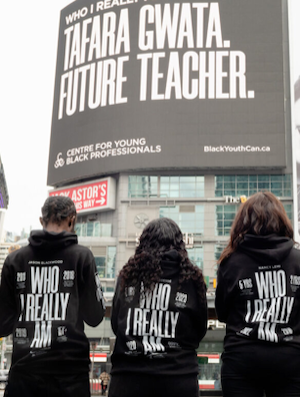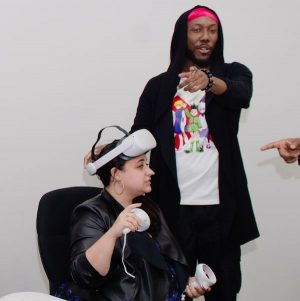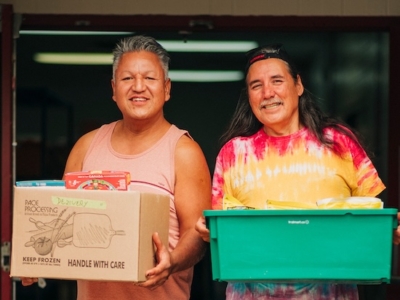 Agapi Gessesse has been the Executive Director of the CEE Centre for Young Black Professionals for six years. Born and raised in Toronto by a refugee mother, Gessesse’s commitment to community development stems from her lived experience. She has a Master’s degree in Social Justice, and has worked with marginalized youth at Toronto Community Housing (TCHC), United Way Greater Toronto (UWGT) and as the Executive Director of POV 3rd Street. She spoke to PANL Perspectives about CEE’s work with Black youth.
Agapi Gessesse has been the Executive Director of the CEE Centre for Young Black Professionals for six years. Born and raised in Toronto by a refugee mother, Gessesse’s commitment to community development stems from her lived experience. She has a Master’s degree in Social Justice, and has worked with marginalized youth at Toronto Community Housing (TCHC), United Way Greater Toronto (UWGT) and as the Executive Director of POV 3rd Street. She spoke to PANL Perspectives about CEE’s work with Black youth.
Question: Why or how did CEE start, and how did you get involved?
 Gessesse: CEE is one of 34 initiatives that came out of the Youth Challenge Fund (YCF), which was established in 2006 in response to the rise of youth violence in Toronto back then. Dr. Kofi Hope founded CEE in 2012. The YCF had focused on young people trying to solve complex challenges in their communities. CEE and Nia Centre for the Arts are the only two out of 34 initiatives that are left.
Gessesse: CEE is one of 34 initiatives that came out of the Youth Challenge Fund (YCF), which was established in 2006 in response to the rise of youth violence in Toronto back then. Dr. Kofi Hope founded CEE in 2012. The YCF had focused on young people trying to solve complex challenges in their communities. CEE and Nia Centre for the Arts are the only two out of 34 initiatives that are left.
I had worked with the YCF and, later, the United Way – and joined CEE six years ago. I have a lot of lived experience, so working with young people and creating opportunities for them is something I’m called to do. I’ve centred my education around that. I’ve centred my work experience around that.
CEE runs programs for five labour gaps in the Canadian market: information technology, trades, entertainment, finance and hospitality. The purpose is to move Black youth from the back of the unemployment line, which where they usually are, to the front. And the way we do that is by providing them with skills for jobs of the future.
The organization’s vision is to create an economy where Black youth can become financially prosperous, live high-quality lives, and contribute to the advancement of Canada.
Q: How many youth have been through the programs – and how does CEE work with them?

“We’re not focused on only jobs. We’re focused on careers, and we’re committed to working with young people who are furthest from the labour market.” –Agapi Gessesse
Gessesse: In our 12 years of existence, we’ve served more than 1,400 young people – and 85% of youth who graduate from our training programs are working in the industry within two years after they’ve graduated.
We have three distinct approaches. Number one is a trauma-informed approach, understanding that by virtue of being a Black youth, you’re probably dealing with a level of trauma that your peers aren’t, and that’s going to be compounded by life experiences by the time you show up at CEE’s door. So, we have full-time psychotherapists to work with our young people, to go a bit deeper and to support them. Often, their biggest challenge is to undo the lies that have been told to Black youth. That’s a big part of the work.

“We have a curriculum that we call CEE Essentials, which is a suite of modules that are centred on Black identity and the workplace. Whether you’re a newcomer or have been here for generations, what brings us together and defines our experience is the Black experience.” –Gessesse
The second approach is person centred. Every young person is different. Some are entrepreneurial, some want to work nine to five, some have children, some have a post-secondary education, some don’t. Social workers talk with youth at CEE before they even enter a training program to figure out what their needs are and to discuss what their plans could be in a program and in the workforce. For example, where do they see themselves going and how do they want to contribute to the economy? These are questions that oftentimes, young people, particularly Black youth, aren’t being asked. They’re just kind of being told, “Take what’s in front of you, and make it work.” Social workers are there to support them with what we call “life stabilization,” such as food security and housing security.
The third approach is a culturally relevant approach. We have a curriculum that we call CEE Essentials, which is a suite of modules that are centred on Black identity and the workplace. Whether you’re a newcomer or have been here for generations, what brings us together and defines our experience is the Black experience. So, how does a Black youth deal with a “situation” at work? How do they even have a conversation with someone in a workplace who, outside of this workplace, they have nothing in common with? How do they communicate so that they’re seen and heard, and so that they can be received? It’s a module focused on soft skills, communication and being Black in a workplace.
Q: Are people tempted to put this kind of training and employment into a DEI box?

“Whether you buy into the DEI conversation or not, Black youth are a solution to Canada’s problems.” –Gessesse
Gessesse: This isn’t about diversity, equity and inclusion. I encourage people not to think solely of the DEI conversation. I think when we box it into that, then employment, jobs, careers become something else, when, actually, Black youth are an untapped talent pool. These young people are brilliant. They’re ready. They’re able.
Whether you buy into the DEI conversation or not, Black youth are a solution to Canada’s problems. They can solve some of this country’s immediate problems related to a shortage of skilled workers in specific industries. This is about empowering our community and our young people. This is about skills and jobs of the future – and for Black youth to decide how they want to contribute.
Organizations like CEE are telling the country: this is what you need to do to get an 85% retention rate with Black young people. Why not invest in them? Black youth and new immigrants are going to be the solution to this country’s job needs. However you feel about DEI, they’ll be the solution — and diversity in the workplace is going to make us much greater and more economically successful as a country.
Q: What’s in the future for CEE in terms of programs?
We want to focus on information technology, entertainment and finance — all three of those areas. How does technology affect industry? How is AI going to affect these industries? How can we teach our young people programs and skills so that, when the time for digital transformation takes place in many of these organizations, they’ll be at the front of the line, with the tools they need.
Agapi Gessesse is on LinkedIn. Photos are courtesy of the CEE Centre for Young Black Professionals.
Sign up for PANL Perspectives, MPNL’s free newsletter.
Tuesday, August 6, 2024 in For homepage, Newcomers & Youth, News & Events, Social Finance
Share: Twitter, Facebook



